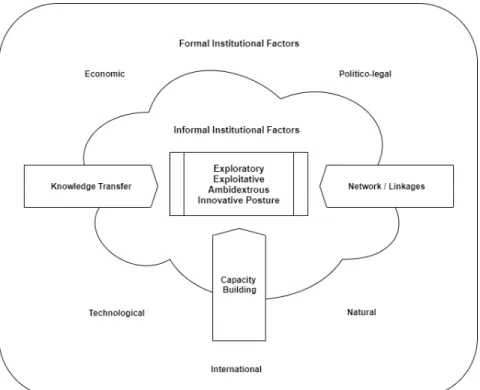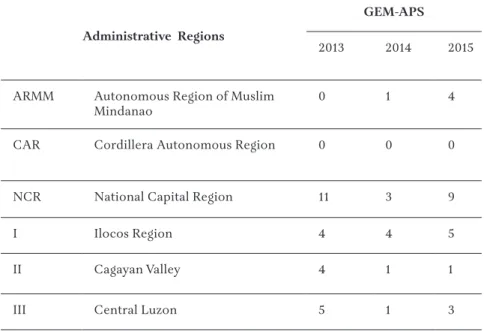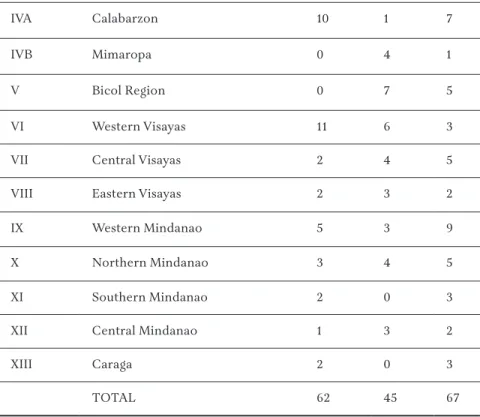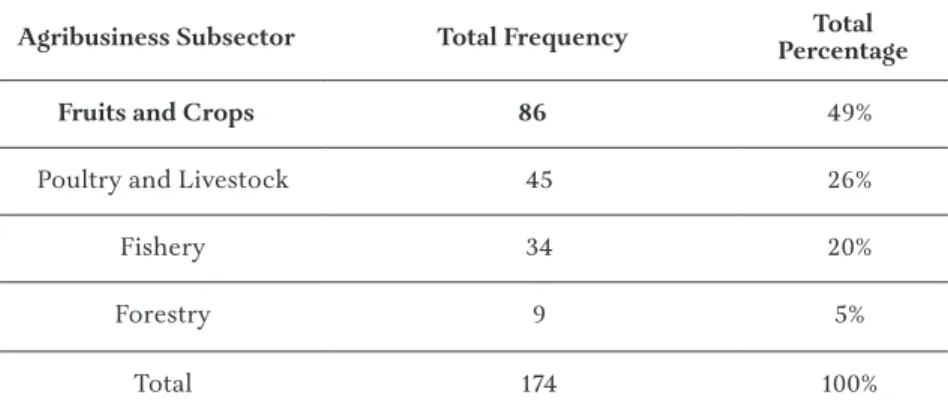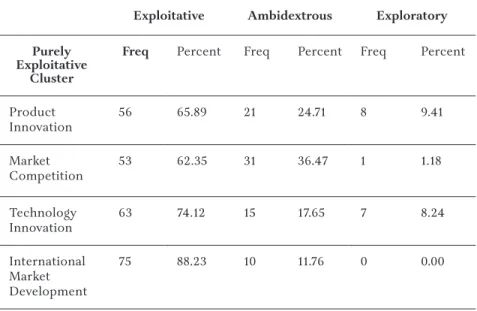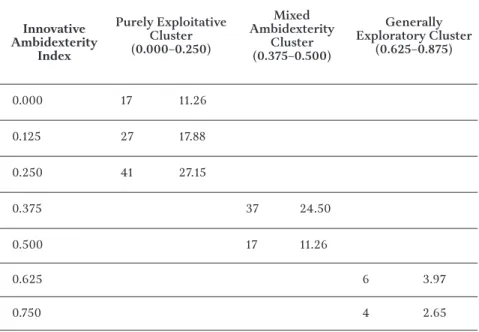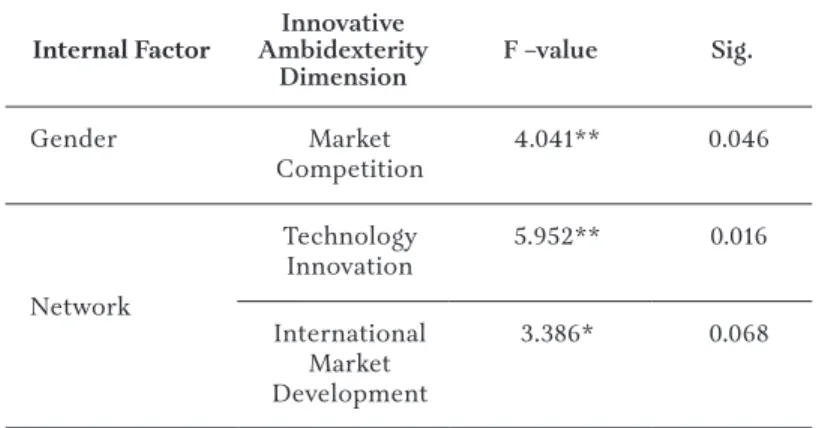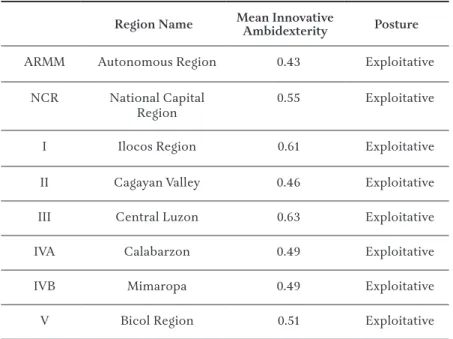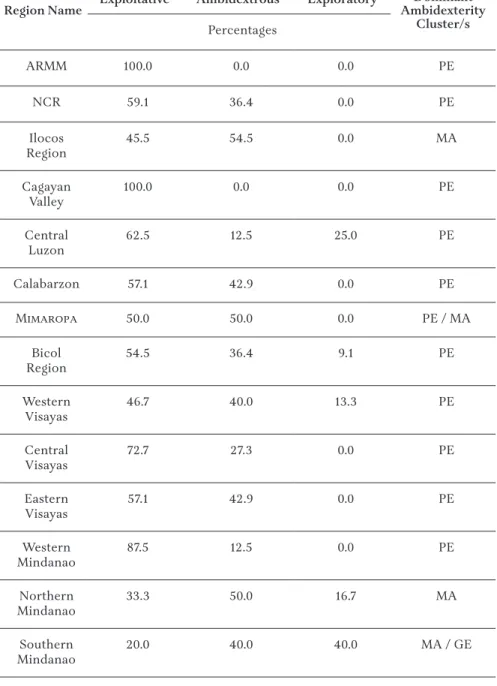An Innovative Ambidexterity Typology of Filipino Agripreneurs and Its Implications for Regional Development Policies
Melodee Marciana E. De Castro and Dinah Pura T. Depositario
Abstract
The innovative ambidexterity lens classifies agripreneurs as having exploratory, exploitative, or ambidextrous postures.
Exploratory agripreneurs exhibit fast and radical innovative behavior, exploitative agripreneurs slow and incremental innovative behavior, whereas ambidextrous agripreneurs are in between. This article proposes a typology of Filipino agripreneurs based on four dimensions of innovative ambidexterity. Data on one hundred and seventy-four (174) Filipino agripreneurs from administrative regions in the Philippines, were derived from the 2013 to 2015 Global Entrepreneurship Monitor Adult Population Surveys (GEM-APS) and analyzed using unsupervised K-means.
Three clusters of Filipino agripreneurs emerged: (1) generally exploratory; (2) purely exploitative; and (3) mixed ambidextrous.
Based on the results, many of the highly exploratory agripreneurs came from the Southern Mindanao and Caraga regions. A closer look at the formal, and informal institutional support in these regions reveals an enabling environment from government agencies in the aforementioned regions. Meanwhile, most of the mixed ambidextrous agripreneurs were from Ilocos, Occidental and Oriental Mindoro, Marinduque, Romblon, and Palawan (MIMAROPA), Northern Mindanao, Southern Mindanao, Central
Mindanao, and Caraga. One commonality among these regions was their all having international airports, which is important to facilitate the transport of products to Manila and international markets. As a recommendation, regional development policies must aim to develop agripreneurs with exploratory, as well as ambidextrous postures. An enabling formal and informal institutional environment (i.e., economic, technological, natural, and political-legal factors, as well as, networks) must be put in place at the regional level for these innovative postures to be developed and for innovations in agripreneurship to be accelerated in the country.
Keywords
innovation, ambidexterity, exploratory innovation posture, exploitative innovation posture, GEM-APS, regional development policies
Introduction
The focus on productivity rather than on entrepreneurial activity has been identified as one of the main causes of the failure of government initiatives to grow the agriculture sector (Santiago and Roxas 2015). A shift in perspective from agricultural production to agripreneurship is considered an essential pathway to revitalize Philippine agriculture. This shift focuses on value creation opportunities all throughout the agricultural value chain from upstream businesses, such as inputs and farm production to the downstream businesses (i.e., processing, marketing, and distribution).
There are, however, challenges that confront agri-enterprises, which include stiff regional competition across international borders, threats of natural disasters, and public health crises as with the recent pandemic. One strategy to counter these challenges is through innovation.
Drucker (1985), in Albert et al. (2017), defined innovation as an entrepreneurial tool to exploit change, given the opportunity of a new business or service. It involves the application of new or significantly improved goods and services, processes of production, marketing strategies, or organizational methods that increase value.
For agripreneurs, innovative behavior may be exploitative (incremental and slow) or exploratory (fast and radical). According to March (1991, 1), exploitation refers to activities as “refinement, choice, production, efficiency, and selection.” On the other hand, activities involving “search, variation, risk taking, experimentation, play, flexibility, discovery” (March 1991, 1) refer to exploitative behavior. Exploratory innovation can lead to long-term benefits, whereas exploitative innovation can pave the way toward greater value addition (Jansen 2005).
Innovation in general can be any of the following forms:
product innovation, market competition, technology innovation, and international market development. Under each dimension, exploitative, as well as, exploratory behaviors can be manifested. In terms of the product innovation dimension, the improvement of the features and quality of agriculture-related products is a manifestation of exploitative behavior. On the other hand, developing a novel agricultural product can be considered as an example of exploratory behavior. Meanwhile, in terms of market competition, attempting to increase the patronage of one’s product in markets, also currently targeted by one’s competitors, is associated with exploitative behavior.
However, when one taps new geographic markets or buyers, this is more of an exploratory behavior. As for technology innovation, utilizing a technology that has been available for a considerable time is an exploitative behavior, whereas utilizing a newly-developed one can be considered as exploratory behavior. Finally, in terms of international market development, exporting a small portion of one’s produce indirectly to a foreign market is a manifestation of exploitative behavior. If one, however, exports a significant portion of one’s produce directly through one’s established channels, then the entrepreneur can be considered as engaged in exploratory behavior.
The concept of innovative ambidexterity was first coined by Čirjevskis (2016). In the context of this study, innovative ambidexterity refers to an entrepreneur’s manifestation of both exploitative and exploratory innovation postures, which would ensure the short-term and long-term existence of the enterprise. With the agribusiness environment becoming increasingly uncertain, dynamic, and challenging, there is an urgent need to develop ambidextrous innovative postures among agripreneurs. An ambidextrous innovation posture,
aside from an exploratory one, can also be translated to achieving longevity in the long run (Karrer and Fleck 2015).
To date, there has been no study that looks into ambidexterity in the context of innovation among Filipino agripreneurs. Thus, this research aimed at proposing a typology of Filipino agripreneurs according to their innovation posture using the exploration- exploitation approach. It also attempted analyzing the regional factors behind the emergence of agripreneurs characterized by these postures.
The putting in place and/or the enhancement of regional development policies, geared toward developing optimal innovation postures among agripreneurs are, therefore, recommended.
Literature Review
Innovation in the Philippines
Based on the 2017 Global Innovation Index, the Philippines ranked 73rd out of the 127 economies and 5th among ASEAN member states, ranking behind Singapore, Malaysia, Vietnam, and Thailand, based on the composite innovation measure of seven pillars: “institutions, human capital & research, infrastructure, market sophistication, business sophistication, knowledge & technology outputs and creative outputs” (Albert et al. 2017, 2).
The 2015 Survey of Innovation Activities (SIA), in Albert et al. (2017), classified establishments as innovation-active if they are product innovators, process innovators, engaged in ongoing innovation projects, and in innovation-related expenditure.
Micro, small, and medium enterprises’ (MSMEs) sources of innovations are classified into: a) internal, b) market-driven, c) institutional, and d) others. For MSMEs, the highest-rated source of innovation are the clients or customers. On the other hand, large firms rated information within their establishment (32.3%) as the most important source of innovation.
There are barriers to innovation, especially in developing countries. One out of five non-innovators reported lack of funds to innovate as the greatest barrier. Other significant barriers are the
knowledge and market factors. Meanwhile, 10% cited the lack of qualified personnel and difficulty in finding cooperation partners.
Others stated uncertainty of demand for innovative products and dominance of established enterprises in the market as significant barriers (Albert et al. 2017).
Llanto and del Prado (2016) confirmed that innovation mediates good performance in the Philippines. Product and process innovations improve sales, profit, and labor productivity. Factors proven to increase the chances of an MSME’s innovation include the firm’s size, age, and foreign equity. Removal of regulatory or structural barriers will attract foreign direct investments and pave the way for the entry of experts and technology. This will also link Philippine MSMEs to global supply chains.
The Philippine Innovation Act and Regional Innovation Republic Act No. 11293, known as the Philippine Innovation Act, was signed on July 23, 2019. It underscores that innovation is a vital component of national development and a driver of sustainable and inclusive growth. Under the Act, an inclusive innovation and entrepreneurship ecosystem is envisioned in the quest for an innovation-driven economy by 2030. These are targeted to be achieved by providing an enabling policy environment, creating a conductive entrepreneurship–innovative culture and government-academia -industry collaborations, and capacity building through upskilling, financing, and industry clusters formation (NEDA 2020).
The Act is instrumental to the creation of the National Innovation Council (NIC), which is a body intended to serve as the country’s policy-making body on innovation. RA 11293 also provides for the formulation of a National Innovation Agenda and Strategy Document (NIASD) by the National Innovation Council (NIC), which will integrate strategies to promote regional innovation that will harness the competitive advantages of regions and provinces (DOST 2021). In connection with this, the Regional Development Councils (RDCs) are tasked to help coordinate and monitor the implementation of the NIASDs in their respective region (NEDA 2021).
It was noted that the NIC will adopt cluster policies or strategies as significant components of the innovation policy mix, and that regional
economic development policy, industrial/enterprise policy, and higher education policy, among others, would be considered by the former.
Further, the cluster policies are expected to focus on regional hubs, provinces, or sectors such as MSMEs, large firms, spin-offs and start- ups, academic or educational institutions, and research centers, or a combination of these (NEDA 2021).
Regional Factors and Innovation
Hernan et al. (2006) claims that national or countrywide institutional frameworks have been highlighted. It is vital to point out that less importance was given to the institutional heterogeneity of regions and cities within a given country. They added that although a national picture of the state of the socio-economic political environment for business (i.e., business climate) helps in describing the business and investment potentials of a country, it unfairly masks the wide disparities among regions and cities within a country. Thus, a clear understanding of how sub-national economic conditions impact the business performance of entrepreneurs operating in the local business environment is needed to stimulate and support entrepreneurship as part of an economic development program.
Dapcus (2006) also made the observation that previous studies dealt with national and local systems of innovation, but the regional system of innovation has been growing in importance in regions of Europe. Howells (2002), as cited by Wang et al. (2015), similarly contended that regions generally differ in terms of their patterns of industrial specialization and other elements of their innovation systems, leading to differing innovation performances.
In a similar vein, Kibler (2013) examined the impact of regional context on the formation of entrepreneurial intentions. His study found that the population density, the level of education, income and wealth, and the rate of public and manufacturing sector employment of a region are found to moderate the individual formation of entrepreneurial intentions.
Meanwhile, the Organisation for Economic Co-operation and Development (OECD) (1998), as cited by McQuaid (2002), argues that entrepreneurship is the result of three public policies working together: 1) the macro environment within which entrepreneurship
takes place; 2) micro-level policies (i.e., well-designed and well-targeted government programs that can encourage and maximize the benefits of collaborative behavior); and 3) supportive cultural attitudes. They defined micro-level policies that promote entrepreneurship as those targeted at individual firms and entrepreneurs, and often developed by local and regional government and agencies (Malecki 1994 in McQuaid 2002). These policies include: advice and training, finance, technology, markets, physical infrastructure, and other policies influencing the characteristics of the locality. McQuaid added that regional and/or local bodies commonly supplement business infrastructure by providing a range of training, information, and advice to assist potential or existing entrepreneurs to improve their learning, develop their business skills, and assess their opportunities (Storey 2000; Glancey and McQuaid 2000 as cited by McQuaid 2002). They may provide basic or advanced courses on taxation, regulations, business practices, opportunity identification, motivation, and technical training, as well as business skills in areas such as bookkeeping, marketing, or generating business or product ideas, with the type and levels of varying support according to the experience of the entrepreneur (Birley and Westhead 1993 in McQuaid 2002).
One of the few studies on regional factors and entrepreneurship is that of Naudé et al. (2008). Their research aimed at identifying the determinants of start-up rates throughout different subnational regions of South Africa. In particular, they investigated the role of access to finance on a regional (subnational) level. They found that the most important determinants of start-up rates throughout South Africa’s magisterial districts are profit rates, educational levels, agglomeration as measured by the economic size of a district, and access to formal bank finance. Further, they found that profits had the strongest effect on start-up rates and that unemployment was insignificant, suggesting that start-ups in South Africa are mainly opportunity-driven (and not necessity-driven). Moreover, they also found that access to formal bank finance matters for regional start- up rates (which is not typical for a developing country), and market- size (agglomerations) is negatively associated with start-up rates in South Africa. This implies the existence of “congesting” factors, such as increased competition, tougher barriers to entry, monopolistic behavior, and a greater difficulty to be innovative and novel.
A similar study was conducted by Alvarez et al. (2011), who analyzed the influence of environmental factors on entrepreneurship at the Spanish regional level. They used data from the Global Entrepreneurship Monitor (GEM) project, specifically from the Spanish National Expert Survey (NES) for environmental conditions and the GEM Adult Population Survey (APS) for entrepreneurial activity. They considered the Total Early Stage Entrepreneurial Activity (TEA) as a dependent variable influenced by formal and informal institution-related factors. Meanwhile, the selected independent variables among the GEM framework conditions, in the light of institutional economics, were formal institutions (i.e., entrepreneurial finance, government policies and governmental programs, research and development transfer, commercial and services infrastructure, market openness, physical infrastructure and intellectual property rights) and informal institutions (i.e., education and training, cultural and social norms, opportunities to start up, abilities and knowledge to start up, entrepreneur social image, women’s support to start up, and interest in innovation). Their data analysis made use of a fixed effects model with panel-corrected standard errors. Their main findings revealed that both informal (cultural and social norms, perception of opportunities to start up, and entrepreneur social image) and formal factors (intellectual property rights) influence entrepreneurship. However, informal factors had a greater impact on entrepreneurial activity than formal factors.
In relation to informal institutions, Vasilchenko and Morrish (2011) found that social networks, which lead to collaborative corporations, facilitate exploitation of internationalization opportunities. ICT companies enter and sustain competitive positions in the global marketplace by developing and using social and business networks. Further, Faroque (2014) claimed that network exploitation and exploration capabilities positively influence international opportunity exploitation and exploration. Lastly, Wang and Hsu (2014) contended that relationship learning contributes significantly to both exploratory and exploitative innovations. Management, on the other hand, should not only concentrate on innovative systems but should also emphasize developing learning relationships with partners.
In relation to GEM and agripreneurship, Arafat, Saleem, Dwivedi, and Khan (2020) studied the cognitive and social capital
factors of entrepreneurial activity in the agriculture industry. They focused on the early-stage activity of agri-business entrepreneurs.
The study, however, did not cover the impact of these factors on innovative posture among agripreneurs. This is the gap that the study attempted to occupy.
In summary, most of the studies reviewed have focused on the link between regional factors with entrepreneurial intention, start- up rates, and business performance. However, studies appear to be limited in relation to the innovative posture of agripreneurs and its link to regional factors.
Ambidexterity Lens
Ambidexterity, as an evolving field in organizational learning, has significantly grown since Duncan’s (1976) initial use of the term, followed by March’s (1991, 1) seminal paper, that stimulated the explosion of literature integrating the exploratory and exploitative dimensions in organizational learning.
March (1991) defined exploration as those activities “captured by search, variation, risk taking, experimentation, play, flexibility, discovery, and innovation,” whereas exploitation means the “refinement, choice, production, efficiency, selection, implementation, execution”
(March 1991, 1). The ambidexterity of organizations, encompassing the exploration and exploitation trade-off, aims to elaborate the adaptive process of organizational learning. Jansen (2006) further compares exploratory and exploitative innovation in Table 1.
Table 1. Comparison of Exploratory and Exploitative Innovation
Exploratory innovation Exploitative innovation Definition Are radical innovations
and are designed to meet the needs of emerging customers or markets
Are incremental innovations and are designed to meet the needs of existing customers and markets
Outcomes New designs, new markets, and new distribution channels
Existing designs, current markets, and existing distribution channels
Knowledge base Require new knowledge and departure from existing knowledge
Build and broaden existing knowledge and skills
Result from Search, variation,
flexibility, experimentation, and risk-taking
Refinement, production, efficiency, and execution
Performance
implications Distant in time Short-term benefits
Adopted from Jansen (2005, 19)
The cultural inertia adopted by successful firms, which dictated conservative dynamism, focused mainly at enhancing process efficiency to maximize generated returns that hindered organizations from mutating into more relevant configurations. To reconcile paradoxical demands, the growth of inconsistent architecture resembles the ambidextrous forms of organizations necessary to survive environmental transitions (Benner 2003). Conversely, the application of ambidexterity on small and medium enterprises (SMEs) revealed contrasting observations. Formalization in SMEs, unlike in large organizations, is not associated with rigidity and exploitation but rather it simplifies operations, thereby fostering exploration.
A close balance of exploration and exploitation mediates influence of structural, contextual, and leadership characteristics on SME performance (Chang and Hughes 2012).
Exploration and exploitation balance, though foreseen to produce distinctive benefits, may be difficult to achieve. Tension balance can be executed contextually via organizational separation (firm level), temporal separation (time), or domain separation (unit level). Defining relevant domains, however, still necessitates further investigation; likewise, how organizations simultaneously balance exploration and exploitation using multiple modes (Lavie, Stettner, and Tushman 2010). Promotion focus positively impacts exploration and exploitation under intense competition (Kammerlander, Burger, and Fust 2014).
Ambidextrous posture is useful when firms operate in competitive markets. At more intense internal rivalry, contextual ambidexterity-
performance relationship is dampened. At low levels of external rivalry, the relationship between contextual ambidexterity and firm performance becomes negative (De Clercq, Thongpapanl, and Dimov 2013).
Knowledge creation processes, involving both exploitation and exploration, should include a set of relevant factors (individual knowledge level, task complexity, and several social network metrics). Team creativity organized through knowledge creation is supported by the balance of exploitation and exploration (Choi and Lee 2015). Social capital is a positive and significant antecedent of both exploration and exploitation (Mura et al. 2014). Incremental innovation is positively influenced by knowledge accumulation capabilities (Fores and Camison 2016). Although structural differentiation does not affect ambidexterity, it has mixed effects on R&D project performance (Chandrasekaran, Linderman, and Schroeder 2012). Learning from distributors weakens firms’ tendency to stress one type of innovation strategy over another.
Further investigations are recommended on defining domains of exploration and exploitation, potential and absorbed slack resources, and complex structures, performance implications and boundary solutions, and special team level characteristics that benefit exploration and exploitation. Extending scope to cross- national differences, use of upstream and downstream information, sectors covering broader geographical context, and data from multiple countries on broader cultural context is desired.
Although more radical and incremental innovation conjecture monotonic firm performance with environment turbulence moderating (Siguaw, Simpson, and Enz 2006), ambidexterity and generative learning influence new product performance, as moderated by competitive intensity in the case of the agricultural region in Turkey (Comez 2016).
In the study of Kortmann (2015), findings suggest that innovation orientation and cost orientation partially mediate the direct influence of ambidexterity-oriented decisions on innovative ambidexterity. Ambidexterity-oriented decisions qualify under strategy formulation, whereas innovation orientation and cost
orientation with strategy implementation. Results mean that strategic subprocesses are vital in enabling ambidextrous innovation behavior.
Following the works of He and Wong (2004), and Jansen (2005), Zhang, Wang and Wei (2019) averaged item scores on exploratory (new products for current markets, new products with new functions, new products based on new technology, and radically improved products) and exploitative innovations (improved current products than develop new products, updated technologies in current products, improved production than acquire new ones, extend function of current products, develop new products by extending current researches to similar fields) to arrive at the composite scale score.
Rodriguez and Hechanova’s (2014) study on Philippine software companies revealed that ambidextrous team behavior is a predictor of innovation and is related to adaptive leadership, particularly with exploratory behavior more highly related to ambidexterity than exploitative behavior. Similarly, those that “prioritized exploration than exploitation were more likely to report financial success”
(Nel, Curtis, and Lehtisaari 2020, 47).
A recent study by Gutierrez and Alvarez (2019) on Global Entrepreneurship Monitor–Adult Population Survey (GEM-APS), specifically on innovative orientation dimensions, investigated product newness, low competition, recent technology, and export orientation as predictors of entrepreneurial growth aspirations with the premise of growth-oriented entrepreneurs’ innovation, technological change, and organizational development critical to business development.
Psychological empowerment (i.e., meaning and impact), associated with entrepreneurial growth attitude, was attributed to entrepreneurial and innovative behavior. Innovative behavior and export orientation significantly predicted sustainable development moderated by financial capital.
As ambidexterity implies that firms deviate from existing products, technologies and practices, network extensiveness and proactive commitment have proven significant contributions (Heavy, Simsek, and Fox 2015). In addition, micro-behaviors of entrepreneurs elicited individual-level dualism as a result of lacking informal job description from external and internal factors (Volery, Mueller, and Siemens 2015).
The development of new products and services is indicative of innovative abilities that directly affect growth. Firms surrounded by less competition have better opportunities for growth. Advanced technologies combined with new products and services will significantly contribute to new ventures’ growth. Export orientation is an essential dimension of entrepreneurial growth aspiration (Gutierrez and Alvarez 2019). More recent investigation on ambidexterity recommends a multidisciplinary perspective to understand determinants, outcomes, and contingencies in relation to international business at different levels (Liu, Collinson, Cooper, and Baglieri 2021).
Given that there is a significant amount of studies on innovation, it was noted that there is still a dearth of research conducted on innovative ambidexterity posture of agripreneurs.
Conceptual Framework of the Study
This study utilized an innovative ambidexterity lens to examine the innovative ambidexterity postures of Filipino agripreneurs in relation to regional factors. Innovative ambidexterity is operationally defined as the balance between exploitative and exploratory innovative postures among Filipino agripreneurs.
The regional factors are classified as formal and informal regional factors. The formal factors consist of the economic, technological, politico-legal, socio-demographic, infrastructural, and natural environments. Meanwhile, the informal institutional factors are the personal and entrepreneurial attributes of the agripreneurs, specifically age, gender, literacy level, and networks, among others.
The institutional factors in this study are considered as either enabling or hindering factors to the development of innovative ambidexterity postures. The innovative ambidexterity postures are exploratory, ambidextrous, and exploitative. They were based on four innovative orientation dimensions: product innovation, market competition, technology innovation, and international market development.
Based on the exploration–exploitation or ambidexterity framework, the innovative posture of agripreneurs can be significantly influenced by regional environmental factors that may enable or deter
processes vital to innovation, such as knowledge transfer, capacity- building, and networking.
Figure 1. Regional Factors Influencing Innovative Ambidexterity Posture of Agripreneurs
Methodology
The Global Entrepreneurship Monitor (GEM) is the largest and most comprehensive database from a centralized global network of member institutions throughout the world. GEM uses a global standardized framework as guide for adult population surveys (APS), individual-level and national export survey (NES), and entrepreneurial framework conditions per country. Started in 1997 by Babson College USA and London Business School UK, the GEM has developed into the global leading consortia that spread in over 100 countries providing a longitudinal study, which comprises 90% of the world’s total Gross Domestic Product (GDP) (Xavier et al. 2014).
The GEM Framework measures the entrepreneurial activities at the individual level throughout the different phases of the entrepreneurial pipeline. Anchoring on GEM sampling design, a multi-stage sampling resulted. The GEM-participating academic teams randomly selected 2,000 adults, ages 18 to 64 years old, nationwide.
Stratifications were based on gender, age, population group, region, and community size. Sample calculations were assessed and approved by the global data team to ensure uniformity across participating economies. In the Philippines, De La Salle University (DLSU), funded by the International Development Research Center, spearheaded and supervised the conduct of the survey in coordination with TNS Philippines, the vendor agency that enumerated the Adult Population Survey through face-to-face interviews. The DLSU Angelo King Institute served as the repository of these databases after responses were encoded and standardized (Xavier et al. 2015).
Coming from a three-year panel data, of at least 2,000 randomly sampled entrepreneurs per year nationwide across all regions in the Philippines, an additional step was undertaken to select only established entrepreneurs belonging to the agricultural value chain.
Out of around 6,000 entrepreneurs in the representative random samples, only 174 were established agripreneurs. In this paper, only established owner-managers from the GEM-APS were shortlisted as participants to hold other underlying factors with uncertainties and complexities involved with early start-ups.
These established owner managers were agripreneurs, ages 18–64, owning and managing an agribusiness enterprise for more than 42 months. GEM recognized established businesses as the core of any country’s economic canvas (Singer, Amoros, and Moska 2015), as well as demonstrating social and economic stability (Hill et al. 2017).
The GEM framework introduced innovative orientation in terms of product/market as to “how much an entrepreneur’s product/service is new to all or some customers” (Singer, Amoros, and Moska 2015, 50) and “if few or no other businesses offer the same product or service”
(Singer, Amoros, and Moska 2015, 50). In addition, GEM also looked at international orientation according to the share of customers living inside and outside the country. Another entrepreneurial aspiration, aside from growth, is internationalization that is “going international”
in order to attain larger markets (Xavier et al. 2015).
The paper focused on proposing a typology of agripreneurs using ambidexterity through unsupervised K-means cluster analysis.
Furthermore, innovative indices of agripreneurs, in each of the generated clusters, were derived. Aside from the descriptive statistics, regressions were performed on proxy variables and innovative postures.
Results and Discussion
Profile of Study Participants
The study participants, consisting of a total of 174 agripreneurs, was derived from the GEM-APS Philippine Economy 2013 to 2015 cross-sectional repeated measures across agricultural value chain stages and subsectors in the Philippines. Only established Filipino agripreneurs had been included in this study, or those who have been in operation for at least three-and-a-half years or 42 months. There were 62 agripreneurs from 2013, specifically 45 from 2014 and 67 from 2015. The number of samples, according to administrative regions, is summarized in Table 2.
Table 2. Regional Distribution of Study Participants
Administrative Regions
GEM-APS
2013 2014 2015
ARMM Autonomous Region of Muslim
Mindanao 0 1 4
CAR Cordillera Autonomous Region 0 0 0
NCR National Capital Region 11 3 9
I Ilocos Region 4 4 5
II Cagayan Valley 4 1 1
III Central Luzon 5 1 3
IVA Calabarzon 10 1 7
IVB Mimaropa 0 4 1
V Bicol Region 0 7 5
VI Western Visayas 11 6 3
VII Central Visayas 2 4 5
VIII Eastern Visayas 2 3 2
IX Western Mindanao 5 3 9
X Northern Mindanao 3 4 5
XI Southern Mindanao 2 0 3
XII Central Mindanao 1 3 2
XIII Caraga 2 0 3
TOTAL 62 45 67
Table 3 presents the number of agripreneurs in this study according to stages and subsectors of the Agricultural Value Chain.
Majority of the agripreneurs from GEM-APS 2013 to 2015 (51.1%) belonged to the distribution stage of the agricultural value chain, followed by processing (31.6%), and farm-production (16.1%). Seventy percent of agripreneurs in the National Capital Region were into processing. Majority of agripreneurs in the Ilocos (92%), Calabarzon (44%), Western Visayas (60%), and Western Mindanao (71%) were into distribution/marketing.
Table 3. Agribusiness Subsectors in the Agricultural Value Chain
Agribusiness Subsector Total Frequency Total Percentage
Fruits and Crops 86 49%
Poultry and Livestock 45 26%
Fishery 34 20%
Forestry 9 5%
Total 174 100%
Most (49%) agripreneurs were classified under fruits and crops, followed by poultry and livestock (26%), and fishery (20%). Only 5% of the GEM-APS Filipino agripreneurs were in the forestry subsector.
All administrative regions were dominated by fruits and crops, except for Ilocos Region dominated by fishery subsector (46.1%) and Eastern Visayas dominated by poultry and livestock (42.9%). Mimaropa (40.0%) and Central Visayas (45.5%) had equal percentages under fruits and crops, as well as poultry and livestock subsectors. The highest regional percentage of the forestry subsector were with Caraga (40.0%) and Cagayan Valley (28.6%).
Innovative Ambidexterity Clusters
The innovation orientation dimensions were utilized to classify Filipino agripreneurs according to their innovative ambidexterity postures. Applying unsupervised K-means cluster analysis, with groupings extracted according to the natural behavior of data relative to the group means, three clusters of Filipino agripreneurs were derived.
The clusters generated were labeled as “purely exploitative,” “mixed ambidextrous,” and the “generally exploratory” clusters based on the posture more consistently manifested across the four dimensions (see Table 8).
Most of the agripreneurs fell under the “purely exploitative”
cluster. In this cluster, the majority manifested exploitative behavior across all the four innovative ambidexterity dimensions. The highest percentage of those in the cluster were exploitative, in terms of
international market development (88.23%) and technology innovation (74.12%).
The second cluster was composed of 54 agripreneurs who exhibited “mixed ambidextrous” posture. In terms of product innovation, the majority (44.44%) of the agripreneurs in this cluster were exploratory.
On the other hand, in terms of market competition, more than half (51.85%) manifested ambidextrous behavior. Meanwhile, the majority exhibited exploitative behavior in terms of technology innovation (44.44%) and international market development (55.56%).
The “generally exploratory” cluster had the least number (12) of agripreneurs. In this cluster, the agripreneurs were predominantly exploratory in terms of product innovation (91.67%), technology innovation (66.67%), and international market development (75.00%).
However, in terms of market competition, 50% were exploitative and 50% were ambidextrous. The number of “generally exploratory”
agripreneurs with ambidextrous posture, in terms of market competition, was quite similar (even lower) when compared with the
“mixed ambidextrous” cluster.
Table 4. Innovative Ambidexterity Clusters of Filipino Agripreneurs from GEM APS 2013 to 2015
Exploitative Ambidextrous Exploratory Purely
Exploitative Cluster
Freq Percent Freq Percent Freq Percent
Product
Innovation 56 65.89 21 24.71 8 9.41
Market
Competition 53 62.35 31 36.47 1 1.18
Technology
Innovation 63 74.12 15 17.65 7 8.24
International Market Development
75 88.23 10 11.76 0 0.00
Mixed Ambidextrous Cluster
Freq Percent Freq Percent Freq Percent
Product
Innovation 13 24.07 17 31.48 24 44.44
Market
Competition 20 37.04 28 51.85 6 11.11
Technology
Innovation 24 44.44 19 35.19 11 20.37
International Market Development
30 55.56 15 27.78 9 16.67
Generally Exploratory Cluster
Freq Percent Freq Percent Freq Percent
Product
Innovation 0 0.00 1 8.33 11 91.67
Market
Competition 6 50.00 6 50.00 0 0.00
Technology
Innovation 1 8.33 3 25.00 8 66.67
International Market Development
1 8.33 2 16.67 9 75.00
The “purely exploitative” cluster exhibited dominantly exploitative posture throughout the four innovative ambidexterity dimensions:
product innovation, market competition, technology innovation, and international market development.
The “mixed ambidextrous” cluster showed dominant exploitative behavior in terms of technology innovation and international development, dominant ambidextrous behavior in terms of market competition, and dominantly exploratory behavior in terms of product innovation.
The “generally exploratory” cluster displayed dominant exploratory behavior in terms of product innovation, technology innovation, and international market development but dominantly exploitative in terms of market competition.
Of the three clusters, the third cluster or the “generally exploratory” agripreneurs was considered by the researchers as the optimal posture for business success. It was noted that more “generally exploratory” agripreneurs had better performance in terms of business longevity of above 10 years (66.7%). They are followed by the
“mixed ambidextrous” agripreneurs and lastly, the “purely exploitative”
agripreneurs. Table 9 classifies business longevity according to innovative clusters.
In addition, the innovative ambidexterity index was further calculated from the normalized scores as presented in the equation.
Table 5 shows the derived innovative ambidexterity indices of GEM-APS from 2013 to 2015, specifically of the established Filipino agripreneurs and their corresponding clusters.
Table 5. Innovative Ambidexterity Index of Established Filipino Agripreneurs from GEM APS 2013 to 2015
Innovative Ambidexterity
Index
Purely Exploitative Cluster (0.000–0.250)
Mixed Ambidexterity
Cluster (0.375–0.500)
Generally Exploratory Cluster
(0.625–0.875)
0.000 17 11.26
0.125 27 17.88
0.250 41 27.15
0.375 37 24.50
0.500 17 11.26
0.625 6 3.97
0.750 4 2.65
0.875 2 1.32
Total 85 56.29 54 35.76 12 7.94
For this study, the purely exploitative cluster agripreneurs had innovative ambidexterity indices from 0.000 to 0.250. The mixed ambidexterity cluster agripreneurs generated indices from 0.375 to 0.500, while the generally exploratory cluster agripreneurs had indices ranging from 0.625 to 0.875. Hence, based on the above results, while at the same time considering the cluster boundaries, the innovative ambidexterity index for Filipino agripreneurs encompassing four innovative ambidexterity dimensions (product innovation, market competition, technology innovation, and international market development) would be as follows:
Purely exploitative 0.000 to 0.437 Mixed ambidextrous 0.438 to 0.562 Generally exploratory 0.563 to 1.000
Considering the business longevity associated with each innovative cluster, the majority of the generally exploratory cluster agripreneurs had more than 10 years business longevity as shown in Table 6.
Table 6. Innovative Ambidexterity Clusters and Business Longevity
Business
Longevity Purely
Exploitative Mixed
Ambidextrous Generally
Exploratory Total 10 years and
below 42 52.5 % 36 67.9 % 4 33.3 % 82
Above 10 years 38 47.5 % 17 32.1 % 8 66.7 % 63
Total 80 53 12 145
Formal Institutional Factors and Innovative Ambidexterity
The formal institutional factors of the external environment contribute to processes that may enable or deter exploration in the regions under study. After appropriate transformations have been applied on the datasets to satisfy the condition of normality, significant influence of regional factors were observed with each innovative ambidexterity dimension. Among the four innovative ambidexterity dimensions studied, product innovation appeared to be most influenced by the formal institutional factors. Interestingly, each of the other three innovative dimensions was proven to be affected by at least one formal factor variable.
The economic activities that surround the agripreneurs contribute to their posture towards innovating product attributes.
Demand for new and improved products “pull” product innovations.
The shared service facilities, which indicate avenues of technology transfer, provide the “push” effect for agripreneurs to product innovate. Product innovation is also significantly influenced by annual precipitation. This is especially true in the case of farm production where the type of commodity is affected to a large extent by the prevailing weather conditions. Likewise, the purchase behavior of consumers is largely affected by weather conditions.
Lastly, product innovation was still seen to be significantly affected by terrorism, even though its R2 coefficient was quite low. In summary, the economic, technological, natural, and politico-legal environment were found to influence the product innovative ambidexterity posture of Filipino agripreneurs.
Table 7. Univariate Regression of Formal Institutional Factors with Innovative Ambidexterity
Innovative
Orientation Formal Factors Proxies (form) R squared P-value
Product Innovation
Economic GRDP per
capita (log) 0.456*** 0.000 Technological SSF (log) 0.193*** 0.003
Natural Annual
precipitation (sqrt)
0.538*** 0.001
Political Terrorism
(dummy) 0.040*** 0.009 Market
Competition Economic GRDP per
capita (log) 0.271 0.263 Technological SSF (log) 0.086 0.461
Natural Annual
precipitation (sqrt)
0.378 0.342
Political Terrorism
(dummy) 0.017* 0.089
Technology
Innovation Economic GRDP per
capita (log) 0.385*** 0.004 Technological SSF (log) 0.212*** 0.003
Natural Annual
precipitation (sqrt)
0.502*** 0.006
Political Terrorism
(dummy) 0.013 0.162
International Market Development
Economic GRDP per
capita (log) 0.403*** 0.001 Technological SSF (log) 0.115 0.182
Natural Annual
precipitation (sqrt)
0.529*** 0.001
Political Terrorism
(dummy) 0.006 0.335
N.B. ***, **, * denote significance at 1%, 5% and 10%.
For market competition, the significant regional factor observed was terrorism. The role of the economic environment on agriculture, hunting, fishery, and forestry sectors manifested significant influence on the market innovative ambidexterity of agripreneurs. Somehow, terrorism also affects agripreneurs’ decision to market innovate at 10%. In relation to shared insights of FGD participants, insurgencies and hostile political environment inhibited agripreneurs’ decision to explore new markets due to security threat to both supply and demand side.
Most regional factors, except terrorism, influenced technology innovation. As technology innovation is dependent on access and availability of technology, the economic environment, as well as support provided by the government for technology transfer, highly promote an enabling innovation ecosystem for agripreneurs to innovate. In the case of perishable produce, the presence and accessibility of suitable technology to lengthen product shelf-life helps diminish uncertainties involved with fluctuating market behavior induced by weather conditions.
Economic and natural proxies were noted to exert high influence on international market development, with domestic economic forces also substantial in international transactions. Aside from GDP, the exchange rate, stock market performance, and inflation impact the Philippine domestic and international economic activities. Further, international market development, which is dependent on channels
and logistics, was found to be affected by weather conditions which was represented by annual precipitation.
Informal Institutional Factors and Innovative Ambidexterity The influence of informal institutional factors on the innovative ambidexterity dimensions were also derived. To confirm causality of significant associations, the multivariate linear model on informal institutional factors was applied with significantly-related factors presented in Table 8. Gender proved to impact market competition at 5% significance. Women agripreneurs in the sample have greater propensity than men in the dimension of market competition. Similarly, network or social capital proved to matter significantly in the areas of technology innovation and international market development.
This implies that relationships with other players and stakeholders are necessary to be exploratory in terms of technology and export.
Access to information and resources are both vital in these fields of innovation.
Table 8. Multivariate Linear Model of Internal Factors on Innovative Ambidexterity
Internal Factor Innovative Ambidexterity
Dimension F –value Sig.
Gender Market
Competition 4.041** 0.046
Network
Technology
Innovation 5.952** 0.016
International Market Development
3.386* 0.068
Mean Innovative Ambidexterity Posture by Region
To get a clearer idea of the formal and informal institutional factors, which can enable the development of exploratory and ambidextrous innovative postures, the prevalent posture of
agripreneurs per region was highlighted. Table 9 presents the mean innovative ambidexterity posture of Filipino agripreneurs per region.
In terms of innovative ambidexterity, only four administrative regions exhibited ambidextrous behavior with Southern Mindanao as the most ambidextrous (0.95). The other thirteen regions’ mean, innovative ambidexterity posture, indicated the dominance of exploitative behavior among their agripreneurs.
Southern Mindanao was closest to the exploratory spectrum.
Also known as Davao Region, Southern Mindanao is composed of five provinces, namely Davao del Sur, Davao Oriental, Davao Occidental, and Compostela Valley; and six cities, particularly Davao, Tagum, Samal Island, Panabo, Mati, and Digos. The region has continued to showcase promising competitiveness and investment climate in years.
Considered as Mindanao’s trade and investment center, the region is also gifted with vast natural resources, efficient road network, airport, and seaport facilities (DTI n.d.).
Table 9. Mean Innovative Ambidexterity Posture of Agripreneurs Across Administrative Regions
Region Name Mean Innovative
Ambidexterity Posture
ARMM Autonomous Region 0.43 Exploitative
NCR National Capital
Region 0.55 Exploitative
I Ilocos Region 0.61 Exploitative
II Cagayan Valley 0.46 Exploitative
III Central Luzon 0.63 Exploitative
IVA Calabarzon 0.49 Exploitative
IVB Mimaropa 0.49 Exploitative
V Bicol Region 0.51 Exploitative
VI Western Visayas 0.59 Exploitative
VII Central Visayas 0.41 Exploitative
VIII Eastern Visayas 0.64 Exploitative
IX Western Mindanao 0.40 Exploitative
X Northern Mindanao 0.77 Ambidextrous
XI Southern Mindanao 0.95 Ambidextrous
XII Central Mindanao 0.88 Ambidextrous
XIII Caraga 0.68 Ambidextrous
N.B. 0–0.66 = exploitative; 0.67–1.33 = ambidextrous; 1.34–2 exploratory
This result that shows that Southern Mindanao is the most ambidextrous among all regions, however, does not support the earlier findings in the study of Albert et al. (2017) stating that location did not matter much except in the case of production innovation. According to Albert et al. (2017), firms in NCR and Balance Luzon were more likely to be product innovators than firms in Mindanao. However, their study’s conclusion applies to all MSMEs in general and was not specifically for agripreneurs. Barroga et al. (2019) found that 21% of Davao Region- based micro, small, and medium food processing enterprises (MSMFEs) under the Department of Science and Technology’ Small Enterprises Technology Upgrading Program (SETUP) Program fully adopted innovations and were at the highly adaptive level. This somehow supports the results of the study as food enterprises (except for service enterprises) are included in the agricultural value chain. In addition, according to one agripreneur in Davao Region who was interviewed to validate this study’s results, government agencies such as the Department of Trade and Industry (DTI), Department of Science and Technology (DOST), and Department of Agriculture (DA) were highly supportive of MSMEs.
The Kruskal Wallis Test of Independence among means results (Table 10) provided proof that there was significant difference in innovative ambidexterity across regions, in terms of product innovation (p-value < 1%) and technological innovation (p-value < 1%), but not in terms of other measures of innovative ambidexterity.
Table 10. Kruskal Wallis Test of Difference of Means Among Regions
SquareChi Asymp. Sig.
Product Innovation 32.540*** 0.004
Technology Innovation 33.951*** 0.002
International Market
Development 18.155 0.200
Innovative Ambidexterity 20.801 0.107
N.B. *** Significant at 1%
Innovative Ambidexterity Clusters Across Regions
The innovative ambidexterity cluster composition across regions are presented in Table 11. Six regions emerged as
“purely exploitative,” particularly ARMM, NCR, Cagayan Valley, CALABARZON, Central Visayas, and Western Mindanao. Five regions were combinations of “purely exploitative” and “mixed ambidextrous” agripreneurs, namely Ilocos, MIMAROPA, Bicol Region, Western Visayas, and Eastern Visayas. Two regions, Central Luzon and Northern Mindanao, had agripreneurs representing all three clusters. On the other hand, three regions (Southern Mindanao, Central Mindanao, and Caraga) had “mixed ambidextrous” and “generally exploratory” agripreneurs.
Table 11. Innovative Ambidexterity Clusters of Agripreneurs across Administrative Regions
Region Name
Purely
Exploitative Mixed
Ambidextrous Generally
Exploratory Dominant Ambidexterity
Cluster/s Percentages
ARMM 100.0 0.0 0.0 PE
NCR 59.1 36.4 0.0 PE
Ilocos
Region 45.5 54.5 0.0 MA
Cagayan
Valley 100.0 0.0 0.0 PE
Central
Luzon 62.5 12.5 25.0 PE
Calabarzon 57.1 42.9 0.0 PE
Mimaropa 50.0 50.0 0.0 PE / MA
Bicol
Region 54.5 36.4 9.1 PE
Western
Visayas 46.7 40.0 13.3 PE
Central
Visayas 72.7 27.3 0.0 PE
Eastern
Visayas 57.1 42.9 0.0 PE
Western
Mindanao 87.5 12.5 0.0 PE
Northern
Mindanao 33.3 50.0 16.7 MA
Southern
Mindanao 20.0 40.0 40.0 MA / GE
Central
Mindanao 16.7 66.7 16.7 MA
Caraga 33.3 33.3 33.3 PE / MA / GE
Conclusions
Theoretical underpinnings of the ambidexterity lens presupposed exploratory and explorative innovation as key to confronting major threats in the environment including intense competition, shocks, and disruptions. This study proposed a typology of innovative ambidexterity of Filipino agripreneurs derived from their innovative orientation dimensions, namely product innovation, market competition, technological innovation, and international market development.
The study revealed three varying postures responding to the formal and informal institutional factors of the regional environments of agripreneurs. They are the purely exploitative, mixed ambidextrous, and generally exploratory agripreneurs. The four dimensions of innovative orientation provided the multifaceted elements completing the exploratory and exploitative innovation posture of agripreneurs.
In addition, innovative ambidexterity indices were derived ranging from 0.000 to 0.37 for purely exploitative agripreneurs, 0.438 to 0.562 for mixed ambidextrous agripreneurs, and 0.564 to 1.000 for generally exploratory agripreneurs.
Findings showed that the dominant Filipino agripreneurs’
posture in most regions of the Philippines was purely exploitative, except for Northern, Central, and Southern Mindanao, as well as, Caraga, which were ambidextrous. Innovation development programs must therefore anchor on scrutinizing regional competitive advantages and dynamic capabilities to create enabling environments that will facilitate knowledge transfer, capacity building, and networking.
As inclusivity is one of the ultimate goals of the Philippine Innovation Act, the Innovation Fund (Section 21) must be able to support investments that would benefit Filipino agripreneurs.
Fund allocations must be administered to strategically boost the
agricultural entrepreneurship of the country leading to social innovation. Similarly, the innovation development credit and financing initiatives must adhere to this purpose.
Similar to the Global Innovation Index, the Philippine Economy GEM database was standardized vis-à-vis other participating economies of the world. Hence, it is a reliable basis for benchmarking with the most successful agribusiness economies in the world.
Benchmarking would favor the creation of strategic Research, Development, and Engineering (RD&E) projects and innovations programs and sustain metrics to gauge Filipino agripreneurs with their foreign counterparts.
Inclusive innovation programs must see to it that no one is left behind. The glaring reality that the agricultural sector, which is the source of the nation’s food basket, remains impoverished sends a compelling signal that the sector should be prioritized in terms of fundamental support and assistance.
Agricultural MSMEs do not have slack resources to use as a buffer amid the threats presented by the external environment.
However, for agripreneurship to succeed, innovation is key.
Innovation, though, entails risk and costs. To be connected to the global value chains puts high pressure on quality, efficiency, and safety. Bottlenecks experienced from supply chain disruptions significantly deter innovation and growth, and consequently, pose a crucial barrier to internationalization.
The study revealed a strong influence of the economic and natural factors on international innovations. Policies that would enable agripreneurs to thrive and compete with the international market should be in place. The resilience of agri-enterprises in confronting climate change and natural disasters, through smart technology and innovation, should be enhanced.
Policy Implications
Southern Mindanao and Caraga were noted to have a substantial number of agripreneurs exhibiting a generally exploratory posture.
Meanwhile, Ilocos, MIMAROPA, Northern Mindanao, Southern
Mindanao, Central Mindanao, and Caraga were found to have more mixed ambidextrous agripreneurs.
Moreover, the formal institutional factors at the regional level, found to be significantly influencing the innovation orientation dimensions of agripreneurs (which were the bases of the innovative ambidexterity postures), were economic, technological, infrastructural, natural, and political-related factors. On the other hand, the informal institutional factors, identified to be remarkably related to innovation orientation dimensions, were network and gender.
The study findings imply that for Philippine agripreneurship to be sustained, regional development policies must enable the development of exploratory and ambidextrous postures among Filipino agripreneurs. The enabling factors to develop exploratory and ambidextrous behaviors are most likely already established in the regions with a significant number of generally exploratory and mixed ambidextrous agripreneurs.
A closer look at the formal, as well as the informal institutional support, in Southern Mindanao and the Caraga regions reveals an enabling environment from government agencies in the aforementioned regions. In 2014, Davao Region developed 11 road maps for its products including abaca, banana, cacao, coconut, durian, mango, and seaweeds, among others, with the assistance from DTI. The road maps for agricultural commodities acknowledged that horizontal issues, such as improving the quality of logistics and transport infrastructure, financing, R&D, and other related support for industries, be addressed (DTI n.d.). Moreover, the DOST Region XI, as well as the DTI and Department of Agriculture (DA) regional offices, have been continuously supporting MSMEs in the region through equipment grants, loans, and training. Meanwhile, the DA–Caraga, through its Agribusiness and Marketing Assistance Division (AMAD), has been tapping various portals to showcase the region’s agriculture and fishery products (Sanchez 2020).
It can also be noted that the most ambidextrous regions, as well as those with combined mixed ambidextrous and generally exploratory agripreneurs, particularly Northern Mindanao, Western Mindanao, Central Mindanao, Caraga, and Central Luzon, all had international airports which facilitated the transport of mostly fruits
and crops to Manila and even international destinations. On the other hand, the regions that were identified to have a combination of purely exploitative, mixed ambidextrous, and generally exploratory agripreneurs (i.e., Ilocos Region, MIMAROPA, Bicol Region, Western Visayas, and Eastern Visayas) were noted to have more access to water (RORO or non-RORO) infrastructure. These regions were engaged in fruit and crops, as well as poultry and livestock production (MIMAROPA, Bicol Region, Western Visayas, and Eastern Visayas) and fisheries production (Ilocos and Bicol Region).
It was also noted that the regions that fared high in terms of technology innovation were the less-congested regions. It seems that a region’s state being congested can be related to “increased competition, tougher barriers to entry, monopolistic behavior, and a greater difficulty to be innovative and novel,” as found by Naudé et al.
(2008) in their study on start-up rates in South Africa. It is, therefore, recommended that regional government units implement urban and rural planning initiatives. This finding also provides support to the need for agri-enterprises to be located and nurtured in regional technology parks and/or technology incubation centers. Hassink (2005), in Gust- Bardon (2012, 17), highlighted the importance of “infostructure instead of infrastructure,” in which the former was explained as “infrastructure facilitating the flow of knowledge and learning process, like technology parks, business incubators, R&D institutes, business environment institutions.”
Further, it was found that typhoons also served as a barrier to technology innovation, hence, it is suggested that regional Local Government Units (LGUs) prioritize putting in place of physical, as well as social infrastructure, which would make agri-enterprises more climate-resilient and sustainable.
On the other hand, regional government agencies should provide more start-up enterprise support in regions with high unemployment rates, especially in regions where there are potential international market players. In addition, as gross regional domestic product (GRDP) was also found to be a predictor of innovative ambidexterity, then there should be an increase in government funding, ideally for all administrative regions.
